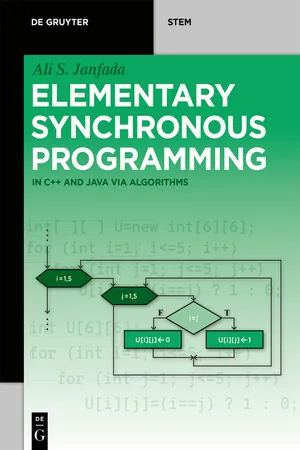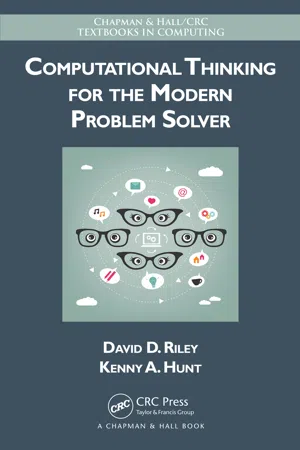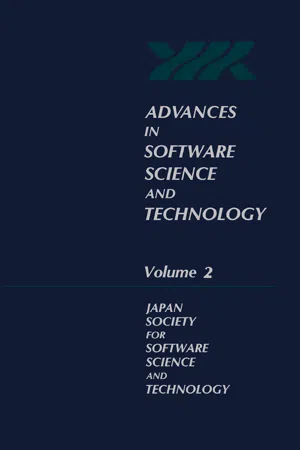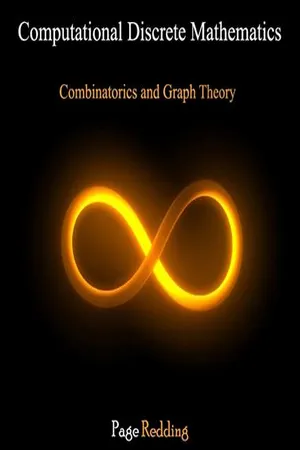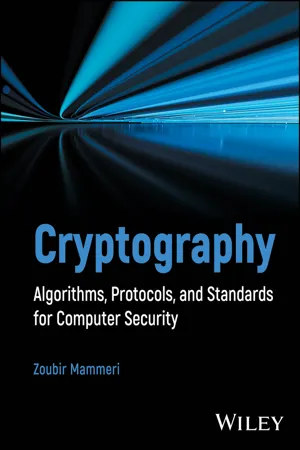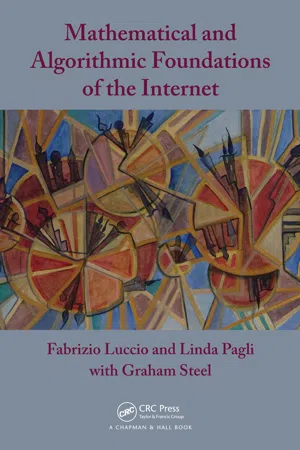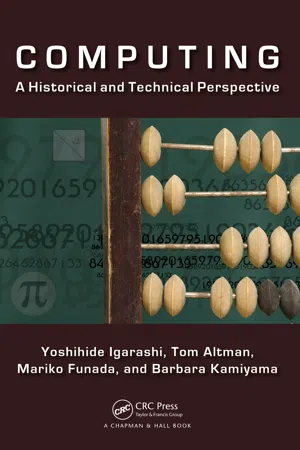Mathematics
Algorithms
Algorithms are step-by-step procedures or formulas for solving problems or performing tasks. In mathematics, algorithms are used to solve equations, find patterns, and analyze data. They are essential tools for computer science, cryptography, and various fields of mathematics, providing systematic approaches to problem-solving and decision-making.
Written by Perlego with AI-assistance
Related key terms
1 of 5
9 Key excerpts on "Algorithms"
- eBook - PDF
Elementary Synchronous Programming
in C++ and Java via algorithms
- Ali S. Janfada(Author)
- 2019(Publication Date)
- De Gruyter Oldenbourg(Publisher)
https://doi.org/10.1515/9783110616484-001 1 Basic concepts of Algorithm 1.1 Algorithm The word algorithm is derived from the name of a great Iranian Muslim mathemati-cian, astronomer, and philosopher named al-Khawrizmi 1 , who lived in the second century anno hegirae. In general, by an algorithm, a set of usually predefined and orderly instructions is meant to be followed to solve a particular type of problem. One may perform various kinds of Algorithms without being aware of them, in their rou-tine and daily lives. For instance, the process of preparing a meal requires several instructions since different stages are needed in cooking and preparing it for serving. Take as another example, attending a church or mosque to say one’s praying. This ritual needs several processes which can be turned into an algorithm. The same ap-plies to robots. These machines are designed based on a special algorithm which in-cludes a set of instructions to implement them in a way that when such instructions are implemented successively, they move harmonically and perform the predesigned tasks accurately. Other instances could be constructing a building, driving a car, tak-ing medicine, setting the table, reading a book, taking a trip, publishing a book, di-recting an office, and many other types of activities. When a mathematical problem is suggested in a classroom, and the corresponding data are presented afterwards. Consequently, particular solutions are expected to be obtained. Accordingly, a prob-lem-solving algorithm is implemented 2 in order to arrive at specific results. Even the processes which follow in somebody’s mind during solving a problem in their per-sonal lives, some kinds of Algorithms occur somewhat differently, for these algo-rithms are not predefined vividly. Having understood a problem, one could investigate various steps to approach the solution. That, in turn, requires several other phases to arrive at a certain finding to the posed problem. - David Riley, Kenny A. Hunt(Authors)
- 2014(Publication Date)
- Chapman and Hall/CRC(Publisher)
130 ◾ Computational Thinking for the Modern Problem Solver actions, and how to reduce complexity by decomposing large problems into smaller units. 5.1 Algorithms An algorithm is a sequence of discrete actions that when followed, will result in achieving some goal or solving some problem. Everyone is accus-tomed to following Algorithms in daily life whether we are aware of it or not. Football players are following an algorithm when they execute a play on the field; drivers are using an algorithm when they follow a set of instructions for getting from one city to another; piano players are using an algorithm when they read and play a musical score; mathematicians are using an algorithm when they use long division to find the ratio of two numbers; and actors are using an algorithm of sorts when they read and execute a script for some theatrical performance. As another example, consider that a recipe is an algorithm that a chef can follow to create a main dish, dessert, or even a drink. Chocolate Chip 1 Cookie Recipe Ingredients • 1 cup melted butter • 2 cups brown sugar • 2 eggs • 3 cups flour • 1 teaspoon baking powder • 1 teaspoon baking soda • 2 cups chocolate chips Directions 1. Preheat the oven to 375 degrees F. 2. Line a cookie sheet with parchment paper 3. In a bowl, stir together the butter, brown sugar and eggs. 4. In a separate bowl, combine the flour, baking powder and baking soda. Gradually combine with the sugar mixture. 5. Add the chocolate chips 6. Fill the cookie sheet with one-spoonful drops of the cookie dough. 7. Bake dough for 9 minutes 8. Cool for five minutes before removing from cookie sheet. Image courtesy of http://www.flickr.com/photos/amagill/34754258/ In the field of computer science, an algorithm is any well-defined sequence of actions that takes a set of values as input and produces some set of values as output. In other words, an algorithm is a sequence of com-putational actions that transform the input into the desired output. A- eBook - PDF
- Yoshio Ohno, Hiroyasu Kakuda, Tsutomu Kamimura(Authors)
- 2014(Publication Date)
- Academic Press(Publisher)
Just as physics has exerted an influence on mathematical concepts, so computer science is today beginning to affect them. This trend is particularly evident in the field of Algorithms. In this article, we consider the history of Algorithms in society and culture. 1 Formation of the Concept of Algorithm in the History of Math-ematics Loosely speaking, Algorithms are procedures for reaching a goal of some kind. How-ever, the range of areas in which Algorithms are used, and indeed, the contents and nature of the Algorithms themselves, are extremely diverse. Copyright © 1991 by Academic Press, Inc. and 1 7 7 Iwanami Shoten, Publishers. All rights of reproduction in any form reserved. ISBN 0-12-037102-2 178 Advances in Software Science and Technology 2, 1990 Algorithms appear in a variety of contexts: as means of obtaining numerical values or function values, as techniques for judging the truth or falsehood of certain types of proposition, and as methods for winning at certain games. Where numer-ical values are computed, a method of computation — an algorithm — is always involved. It seems useful to distinguish between the discovery and simple execution of the procedure for performing calculations on the one hand, and an awareness of Algorithms on the other. By awareness we mean the realization that if opera-tions or manipulations are performed according to the algorithm, the desired result will be obtained. It would seem that such an awareness appeared only long after Algorithms themselves. While it is difficult to distinguish clearly between the two, if one could find examples of Algorithms devised out of curiosity, not prompted by practical considerations, for studying the behavior of problems and solutions, this would constitute evidence that by that time at the latest, Algorithms themselves had become objects of investigation. - eBook - PDF
- Rex Porbasas Flejoles(Author)
- 2019(Publication Date)
- Arcler Press(Publisher)
FUNDAMENTALS OF Algorithms CHAPTER 1 CONTENTS 1.1. Introduction ........................................................................................ 2 1.2. Different Types of Problems Solved by Algorithms ............................... 4 1.3. Data Structures ................................................................................... 8 1.4. Algorithms as a Technology ................................................................. 9 1.5. Algorithms and Other Technologies .................................................. 11 1.6. Getting Started With Algorithm ......................................................... 13 1.7. Analyzing Algorithms ........................................................................ 18 References ............................................................................................... 25 Introduction To Algorithms 2 1.1. INTRODUCTION We define an algorithm as any well-defined computational method that takes input in the form of any value, or else set of values, and resultantly produces any value, or else set of values, as output. Hence, an algorithm is considered a sequence of computational steps which transforms any input into the output. Another way of seeing algorithm is to consider it as a tool that solves a well-specified computational problem (Aggarwal & Vitter, 1988; Agrawal et al., 2004). Generally, the statement of the problem postulates the desired relationship between input and output; whereas, the algorithm defines a particular computational process for achieving that relationship between input and output. For instance, suppose that we want to sort a sequence of numbers into an increasing order. This problem arises quite often in practice and makes available a fertile ground for presenting numerous standard design practices as well as analysis tools (Adel’son-Vel’skii & Landis, 1962; Abramowitz & Stegun, 1965). - No longer available |Learn more
Computational Discrete Mathematics
Combinatorics and Graph Theory
- (Author)
- 2014(Publication Date)
- Orange Apple(Publisher)
________________________ WORLD TECHNOLOGIES ________________________ Chapter- 7 Algorithm and Graph Theory Algorithm This is an algorithm that tries to figure out why the lamp doesn't turn on and tries to fix it using the steps. Flowcharts are often used to represent Algorithms graphically. In mathematics, computer science, and related subjects, an algorithm (derived from the name of mathematician al-Khwārizmī) is an effective method for solving a problem expressed as a finite sequence of steps. Algorithms are used for calculation, data ________________________ WORLD TECHNOLOGIES ________________________ processing, and many other fields. (In more advanced or abstract settings, the instructions do not necessarily constitute a finite sequence, and even not necessarily a sequence; see, e.g., nondeterministic algorithm.) Each algorithm is a list of well-defined instructions for completing a task. Starting from an initial state, the instructions describe a computation that proceeds through a well-defined series of successive states, eventually terminating in a final ending state. The transition from one state to the next is not necessarily deterministic; some Algorithms, known as randomized Algorithms, incorporate randomness. A partial formalization of the concept began with attempts to solve the Entscheidungsproblem (the decision problem) posed by David Hilbert in 1928. Subsequent formalizations were framed as attempts to define effective calculability or effective method; those formalizations included the Gödel–Herbrand–Kleene recursive functions of 1930, 1934 and 1935, Alonzo Church's lambda calculus of 1936, Emil Post's Formulation 1 of 1936, and Alan Turing's Turing machines of 1936–7 and 1939. The adjective continuous when applied to the word algorithm can mean: 1. An algorithm operating on data that represents continuous quantities, even though this data is represented by discrete approximations – such Algorithms are studied in numerical analysis; or 2. - eBook - PDF
- Roland Backhouse(Author)
- 2014(Publication Date)
- Wiley(Publisher)
The notion of an algorithm hardly needs any introduction in our modern computerised society. It is not that Algorithms have only recently come into existence. On the contrary, Algorithms have been used for millennia. Algorithms are used, for example, in building and in measurement: an algorithm is used when tunnelling through a mountain to ensure that the two ends meet in the middle, and cartographers use Algorithms to determine the height of mountains without having to climb up them. But, before the computer age, it does not seem to have been considered important or relevant to emphasise the algorithm being used. 1.1 A L G O R I T H M S An algorithm is a well-defined procedure, consisting of a number of instructions that are executed in turn. In the past, Algorithms were almost always executed by human beings, which may explain the earlier lack of emphasis on Algorithms. After all, human beings are intelligent and cope well with imprecise or incomplete instructions. Nowadays, however, Algorithms are being automated more and more often and so are typically executed by computers, 1 which can at best be described as ‘‘dumb’’ machines. As a consequence, the instructions need to be both precise and very detailed. This has led to major new challenges that tax our problem-solving ability and to major changes in what 1 Long ago a ‘‘computer’’ was understood to be a person, so we should really say ‘‘electronic digital computer’’. However, we now take it for granted that this is the sole meaning of the word ‘‘computer’’. 4 ALGORITHMIC PROBLEM SOLVING we understand as the solution to a problem. The computer age has revolutionised not just our way of life, but also our way of thinking. 1.2 A L G O R I T H M I C P R O B L E M S O LV I N G Human beings are quite good at executing Algorithms. For example, children are taught at an early age how to execute long division in order to evaluate, say, 123456 divided by 78 and its remainder, and most soon become quite good at it. - eBook - PDF
Cryptography
Algorithms, Protocols, and Standards for Computer Security
- Zoubir Z. Mammeri(Author)
- 2024(Publication Date)
- Wiley(Publisher)
59 Cryptography: Algorithms, Protocols, and Standards for Computer Security, First Edition. Zoubir Z. Mammeri. © 2024 John Wiley & Sons Inc. Published 2024 by John Wiley & Sons Inc. 3 Mathematical Basics and Computation Algorithms for Cryptography Cryptography is a discipline that requires a background in mathematics. All encryption, decryption, and signature algo- rithms are based on notions and theorems known in number theory, modular arithmetic, and abstract algebra. Before we start the presentation and analysis of cryptographic Algorithms, we need to review basics from number theory and abstract algebra. This chapter aims to review and present, with examples and exercises, the mathematical background to address cryptography Algorithms. Seminal theorems are given with the names of their authors. Proofs of theorems are not included in this chapter and can be found in many books and papers on the topics [1–6]. To make attacks against cryptosystems computationally infeasible, numbers used in cryptographic Algorithms are very large (in magnitude of 2 2 2 160 256 2048 , , , etc.). Therefore, optimized (in term of execution time) computation methods are needed. In addition to mathematical basics, Algorithms commonly used to do fast computations in cryptographic algo- rithms are addressed in this chapter. Finally, the birthday paradox is presented; it is useful for the analysis of attack complexity. According to the mathematics and computation Algorithms skills of the reader, he/she may: ● Skip this chapter and address directly cryptographic Algorithms. ● Learn basics, move to cryptographic Algorithms, and return to this chapter to retrieve the needed facts and results. ● Learn the basics and theorems and deepen through the examples and exercises included, then move to cryptographic Algorithms. - Fabrizio Luccio, Linda Pagli, Graham Steel(Authors)
- 2011(Publication Date)
- CRC Press(Publisher)
Chapter 4 The algorithm: the key concept How shameless Martin applies mathematical logic when courting girls, and how a police officer may be unable to identify a criminal gang in the Web. The algorithm 1 is the key concept of this book. When in the 1930s Alan Turing and other logicians came up with a sound definition of the algorithm, computer science took its first steps, although no computers had yet been invented. Algorithms accompanied the growth of this new science up to the Internet and through to the Web era where they lie at the foundation of everything. Based on the primitive concepts discussed in the previous chapters we will now illustrate several Algorithms to be used later as building blocks, starting from the indispensable theoretical foundations of our discussion. Let us return to the world of sequences. Our analysis will not lose generality if we restrict this world to the binary case that interests us most. Call these sequences σ 0 , σ 1 , σ 2 , ... and arrange them in canonical order , i.e., by increasing length and, for the same length, by increasing value of the corresponding binary numbers, starting from the empty sequence . We have: σ 0 σ 1 σ 2 σ 3 σ 4 σ 5 σ 6 σ 7 σ 8 ... σ 14 σ 15 ... 0 1 00 01 10 11 000 001 ... 111 0000 ... (4 . 1) i.e., the binary sequences can be put in a one-to-one correspondence with the natural numbers 0, 1, 2, .... , or, in the terminology of set theory, such sequences are numerable . Adopting the numbering induced by the canonical order, for any given sequence σ i we can reconstruct in finite time its number i , and vice versa, no matter how long the sequence is. Keep in mind that we are talking of sequences of finite but unbounded length, that is, for any length l arbitrarily fixed there are (infinite) sequences longer than l . This infinite world of numerable objects has attracted thinkers since an-cient times.- eBook - PDF
Computing
A Historical and Technical Perspective
- Yoshihide Igarashi, Tom Altman, Mariko Funada, Barbara Kamiyama(Authors)
- 2014(Publication Date)
- Chapman and Hall/CRC(Publisher)
255 C H A P T E R 27 The Design of Computer Algorithms As described in Chapter 18, computers were traditionally built to calculate the solution to numerical problems such as the determination of the roots of an algebraic equation, or to process numerical data, e.g., the statistical calculation of national consensus data. However, for the last 40 years or more, a great deal of important work has also been done by computers for nonnumerical problems, such as sorting, searching, word or language processing, and solving combinatorial problems in software development, data communication, and the simulation of various biological, chemical, and physical processes. The design and analysis of computer Algorithms have been developed in the context of such applications. 27.1 SORTING AND SEARCHING Sorting a sequence of numeric or alphanumeric items means rearrang-ing them in some specific order. Since a significant portion of data pro-cessing involves sorting, efficient sorting Algorithms are of considerable importance for many practical problems [3, 7]. Sorting is one of the first problems for which Algorithms were formally analyzed and evaluated. It is considered to be a fundamental problem in the area of algorithmics , mainly because sorting often plays an essential part of many Algorithms. For example, sorting significantly facilitates a search for elements in some set or a list. A dictionary is a typical example of a sorted list. Words in a dictionary are usually arranged in an alphabetical order, which allows us to easily locate the word that we are trying to find in the dictionary. 256 ◾ Computing Some sorting methods were in use long before the invention of computers. For example, a card player sorts the cards of his hand so that each card is visible and individually accessible. Suppose that A , 2, 3, 4, 5, 6, 7, 8, 9, 10, J , Q , K are the order of the cards. The following method has been com-monly used among card players.
Index pages curate the most relevant extracts from our library of academic textbooks. They’ve been created using an in-house natural language model (NLM), each adding context and meaning to key research topics.
